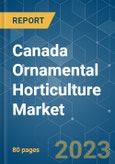Key Highlights
- The Canadian ornamental horticulture sector includes floriculture (Greenhouse flowers and potted plants) and nursery. According to Agriculture and Agri-Food Canada, in the year 2021, the total number of nurseries accounted for 1,840 followed by the Greenhouses with specialized flower producers at 1,557, sod accounted for 223 and field-grown cut flowers accounted for 189. The total area of Canadian ornamental farms is accounted for 37,956 hectares.
- The adoption of greenhouse products increased primarily because of an increase in greenhouse fruit and vegetable (+9.3%) and greenhouse flowers and plants (+7.3%). Greenhouse products accounted for 80.5% of the total value in that industry, while nursery products (15.7%), sod (3.2%), and field cut flowers (0.6%) accounted for the remainder.
- The total sod area increased nationwide, up 3.7% to 21,168 hectares in 2021, following five years of declines. The Sod area has been steadily on the rise since 2019, having increased by 13.4%. Similarly, in the year 2020, Eastern Canada was the fastest increase in sod usage, led by Nova Scotia, Prince Edward Island, and Quebec. Ornamental products are distributed through multiple channels. Retail outlets and Retail Florist are the primary distributors of floriculture products, accounting for 11.4% of total products in 2021.
Canada Ornamental Horticulture Market Trends
Export Drives the Ornamental Horticulture Category in the Country
Canada’s largest ornamental trade partner continues to be the United States and France. According to the ITC Trademap, the export value accounted for 99.9% of the United States and 3.14% of imports in this sector. Canada’s worldwide exports of cut flowers totaled USD 82,031 thousand, and imports accounted for USD 147,506 thousand in the year 2021. In 2020, greenhouse-grown plants and cut flowers like geranium, miniature roses, petunias, chrysanthemums, and orchids are majorly produced in the country for exports accounted for 12,610 thousand, 8,531thousand, 5,070 thousand, 4,936 thousand, and 4,474 thousand.According to Agriculture and Agri-Food Canada, in February 2022, nearly USD 460,000 through the AgriMarketing Program, Flowers Canada Growers (FCG) supported marketing activities to promote the benefits of Canada’s floriculture products, which will help to increase sales throughout Canada and the United States. In addition, FCG will also work with farmers and floriculture businesses to provide trade-related information and support, training, and certification to enhance industry knowledge and maintain access to international markets.
Ontario is Leading the Floriculture Industry in Canada
The growing demand for fresh-cut flowers, potted flowering plants, and bedding plants in Canada. Ontario, British Columbia, and Quebec accounted for the majority of Canada’s total floriculture sales, with Ontario contributing more than half of Canadian sales at 55.2% in the year 2021.According to Agriculture and Agri-Food Canada, Ontario is an agricultural powerhouse that leads in many farming categories. Nursery product sales and resales were up 6.9% to USD 727.0 million in 2020, accounting for 28.6% of total ornamental sales. By province, Ontario accounted for the largest share of total nursery sales (41.8%), followed by British Columbia (32.0%) and Quebec (14.5%). According to the Ontario Ministry of Agriculture, Food and Rural Affairs (OMAFRA), growing population, adverse climate conditions, the proximity to US markets along with the presence of large technologically advanced operations, have all contributed to the growth in the floriculture segment in Ontario.
While most floriculture production takes place within climate-controlled greenhouses, most nursery production takes place outdoors. The nursery industry is typically more vertically integrated than the floriculture industry with a combination of retail sales (garden centers), landscaping, installation, and maintenance services forming part of the income mix for many producers. The total turf sod area decreased nationwide for the sixth consecutive year, down 2.4% to 18,215 hectares in 2020; while the total value of turf sod sales rose by 2.6% to USD 137.5 million, accounting for 5.4% of total ornamental sales. Ontario led the country in turf sod sales (USD 54 million) at 39.4% of the national total.
Additional Benefits:
- The market estimate (ME) sheet in Excel format
- 3 months of analyst support
This product will be delivered within 2 business days.










